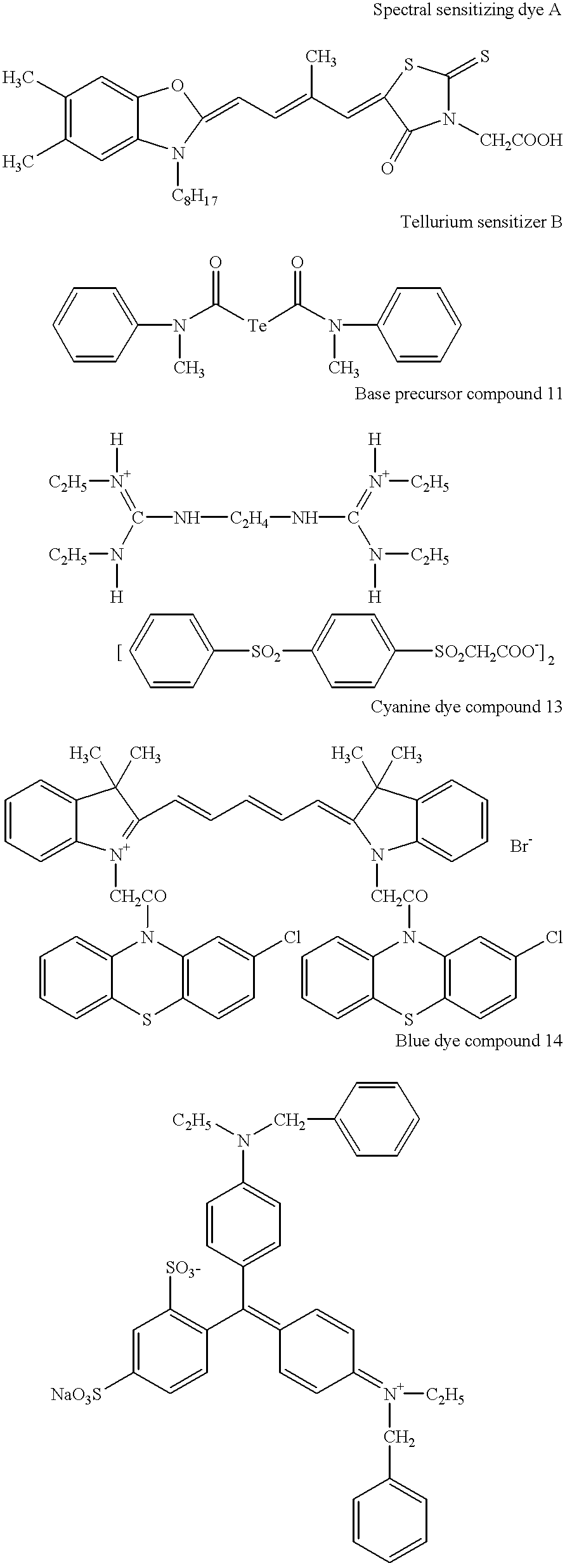Thermally processed image recording material
a technology of image recording and thermal processing, applied in the direction of auxillary/base layers of photosensitive materials, instruments, photosensitive materials, etc., can solve the problems of insufficient film-forming properties, inability to obtain sufficient film-forming properties, and inability to meet the requirements of medical images
- Summary
- Abstract
- Description
- Claims
- Application Information
AI Technical Summary
Benefits of technology
Problems solved by technology
Method used
Image
Examples
synthesis example
[0141] Synthesis of Polymer Latex P-5
[0142] In an autoclave made of glass (TEM-V1000, Taiatsu Glass Kogyo Co., Ltd.), 94.5 g of styrene, 280 g of distilled water and 4 g of surfactant (Sandet BL, SANYO CHEMICAL INDUSTRIES, LTD.) were placed and stirred for 1 hour under a nitrogen flow. Then, the reaction vessel was sealed, added with 55.5 g of butadiene, and warmed to 60.degree. C. The reaction mixture was added with 20 g of 5% aqueous solution of potassium persulfate and stirred for 10 hours. Then, the reaction mixture was added with 132 g of styrene, 15 g of butadiene and 3 g of acrylic acid, and further stirred for 10 hours to allow the reaction. After the reaction was completed, the temperature were lowered to room temperature, and the reaction mixture was added with 148 g of distilled water and stirred for 30 minutes to obtain latex as milky white liquid.
example 1
[0143] >
[0144] (1) Preparation of PET Support
[0145] Using terephthalic acid and ethylene glycol, polyethylene terephthalate (PET) having an intrinsic viscosity IV of 0.66 (measured in phenol / tetrachloroethane=6 / 4 (weight ratio) at 25.degree. C.) was obtained in a conventional manner. The PET was pelletized, and the pellets were dried at 130.degree. C. for 4 hours, melted at 300.degree. C., extruded from a T-die, and quenched to prepare an unstretched film having such a thickness that the film thickness after thermal fixation should become 175 .mu.m.
[0146] The film was stretched along the longitudinal direction by 3.3 times at 110.degree. C. using rollers having different peripheral speeds and then stretched along the transverse direction by 4.5 times at 130.degree. C. using a tenter. Thereafter, the film was subjected to thermal fixation at 240.degree. C. for 20 seconds and relaxed by 4% along the transverse direction at the same temperature. Then, after chucks of the tenter were re...
PUM
| Property | Measurement | Unit |
|---|---|---|
| temperature | aaaaa | aaaaa |
| glass transition temperature | aaaaa | aaaaa |
| glass transition temperature | aaaaa | aaaaa |
Abstract
Description
Claims
Application Information
 Login to View More
Login to View More - R&D
- Intellectual Property
- Life Sciences
- Materials
- Tech Scout
- Unparalleled Data Quality
- Higher Quality Content
- 60% Fewer Hallucinations
Browse by: Latest US Patents, China's latest patents, Technical Efficacy Thesaurus, Application Domain, Technology Topic, Popular Technical Reports.
© 2025 PatSnap. All rights reserved.Legal|Privacy policy|Modern Slavery Act Transparency Statement|Sitemap|About US| Contact US: help@patsnap.com

